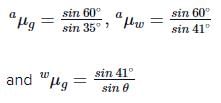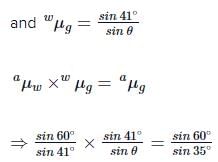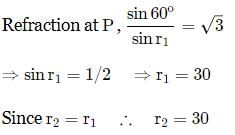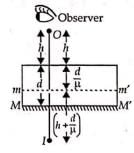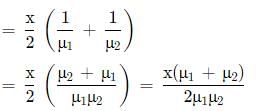Test: Refraction (NCERT) - NEET MCQ
10 Questions MCQ Test NCERTs at Fingertips: Textbooks, Tests & Solutions - Test: Refraction (NCERT)
Which of the following is correct for the beam which enters the medium?
Refraction of light from air to glass and from air to water are shown in figure (i) and figure (ii) below. The value of the angle θ in the case of refraction as shown in figure (iii) will be
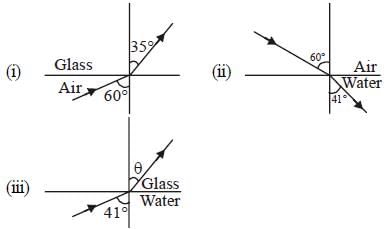

A ray of light strikes a transparent rectangular slab of refractive index √2 at an angle of incidence of 45°. The angle between the reflected and refracted rays is:
A ray of light is incident on a thick slab of glass of thickness t as shown in the figure. The emergent ray is parallel to the incident ray but displaced sideways by a distance d. If the angles are small then d is
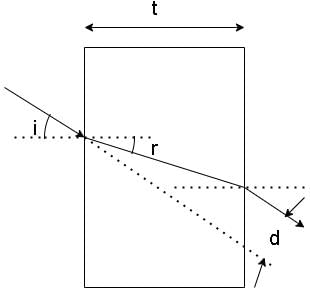
A ray incident at a point at an angle of incidence of 60∘ enters a glass sphere of refractive index √3 and is reflected and refracted at the farther surface of the sphere. The angle between the reflected and refracted rays at this surface is
The apparent depth of a needle lying at the bottom of the tank, which is filled with water of refractive index 1.33 to a height of 12.5cm is measured by a microscope to be 9.4cm. If water is replaced by a liquid of refractive index 1.63 upto the same height. What distance would the microscope have to be moved to focus on the needle again?
A point luminous object (O) is at a distance h from the front face of a glass slab of width d and of refractive index μ. On the back face of a slab is a reflecting plane mirror. An observer sees the image of an object in the mirror as shown in the figure. Distance of image from front face as seen by observer will be :
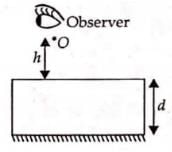
A vessel of depth x is half filled with oil of refractive index μ1 and the other half is filled with water of refractive index μ2 The apparent depth of the vessel when viewed from above is
Three immiscible liquids of densities d1 > d2 > d3 and refractive indices μ1 > μ2 > μ3 are put in a beaker. The height of each liquid column is h/3. A dot is made at the bottom of the beaker. For near normal vision, find the apparent depth of the dot.
A tank is filled with water to a height of 15.5 cm. The apparent depth of a needle lying at the bottom of the tank is measured by a microscope to be 8.5 cm. If water is replaced by a liquid of refractive index 1.94 upto the same height, by what distance would the microscope have to be moved to focus on the needle again ?
|
237 docs|243 tests
|


